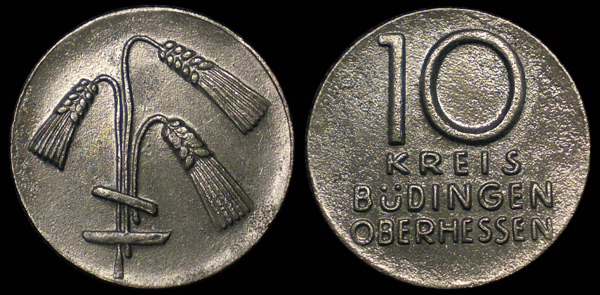
BUDINGEN (GERMAN) 10 PFENNIG UNDATED
L- 61.1 The Town of Büdingen (Hessen) Zinc 10 Pfennig Coin Depicting Grain.
This simple but attractive zinc coin depicting grain was issued by the town of Büdingen and was meant to be used as small change. The reverse of the coin reads 'Kreis Büdingen Oberhessen' roughly translated as 'Circle Büdingen Upper Hessen'. This coin is not dated. Büdingen is a located in the damp southwestern foothills of the Vogelsberg Mountains in the German State of Hesse.
There had already been settlements in the area well before 700 AD when an unknown lord built the ancient church of Saint Remigius which still stands relatively unchanged today. The town began in earnest with the construction of the moated castle in the 12th century and the development of a new settlement around it. The castle would become the nucleus of the town and it would remain so for the rest of Büdingen's history.
The noblemen of Büdingen became the Burggrafen (castle counts) of Gelnhausen in 1155. The lords of Büdingen enjoyed close connections with the Staufen dynasty and were among the most important exponents of imperial Staufen politics in the Rhine-Main-area. Under Frederick I (Barbarossa), King of Germany and Holy Roman Emperor, they were granted the privilege of being a free imperial town in 1170.
The general policy of the Staufen was to centralize and to secure the scattered properties of the empire by means of systematically building castles. Thus the moated imperial castle of Büdingen was built under the supervision of Hartmann of Büdingen, Burggraf of Gelnhausen. It became his county seat.
In about 1250, with the death of Gerlach II, the family of the lords of Büdingen died out and the county would be divided among in-laws and relatives. Louis I of Ysenburg, whose family was somehow connected to the old lords of Büdingen, would take up residence in the castle. In 1323 the Ysenburg family gained exclusive possession of Büdingen Castle and have called the castle home, with some exceptions, for more than 700 years.
In 1330, Luther of Ysenburg was granted the privilege to have a market in the town by the Emperor Louis the Bavarian. The town grew and by the 15th century the Ysenburgs under Diether and his son Louis II had extended their territory considerably. In 1442 the Ysenburgs became counts of the empire, subordinate only to the emperor.
A little before 1500, Count Louis II built the imposing fortifications around the two quarters of the town that can still be seen today. After the death of Count Louis his sons quarreled and in 1517 the property was split. One branch of the family died out in 1601 and it was reunified under one ruler, Count Wolfgang Ernst, who brought Calvinism to Büdingen. The town would later become a haven for different religious movements.
Wolfgang Ernest's sons would oppose the empire during the Thirty Years War. As convinced adherents of the protestant cause they sided with the Swedish king, Gustav Adolf. After the defeat of the Swedes in the battle of Noerdlingen in 1634, Büdingen castle and town were taken and looted by the imperial troops. The counts of Ysenburg fled to nearby Hanau and the county was occupied by the Landgraf of Hesse-Darmstadt. The counts would not be restored until the signing of the Westphalian Peace Treaty in 1648. In the 19th century, the members of the families of Ysenburg-Büdingen and of Ysenburg-Waechtersbach were granted princely status.
Today Büdingen is a modern town steeped in history, its castle and its numerous medieval-era buildings nestled in the green foothills make it an ideal place to visit. The castle, having escaped destruction and having never been rebuilt or significantly remodeled, remains relatively unchanged from its original form.
Büdingen became a garrison town in 1936. American troops were stationed there from 1945 until 2007 when they withdrew ending Büdingen's 71 years as a military garrison.
|
| Extensive defensive walls made Budingen a medieval stronghold. These walls and towers still stand nearly complete, very rare in Germany after the devestation of World War II. View of the "Jerusalem Gate" (above). |

